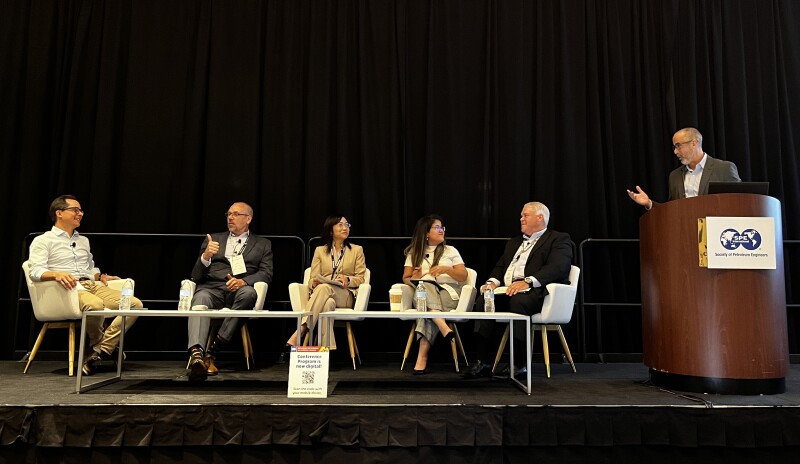Many operators aim to reduce emissions at legacy oil and gas assets, but if the method isn’t cost-effective, it’s hard to get buy-in for a solution.
At the same time, service companies are innovating technologies that can make a difference but sometimes struggling to find pilot opportunities for that tech.
Collaboration—whether amongst service companies or between service companies and operators—could help reduce emissions while still protecting the operator’s bottom line and generating revenue for the service companies, industry experts said during a panel session at SPE’s Artificial Lift Conference & Exhibition on 22 August.
Dakai Yin, electrical submersible pump (ESP) advisor at Occidental Petroleum Corp., said solutions have to make financial sense for existing wells. It wouldn’t make sense, she said, to buy brand new drives for a well that’s only producing 10 BOPD.
“As an operator, we cannot afford to replace everything,” she said, urging service companies to help operators retrofit existing wells with newer, affordable tech. One consideration is “how much you consume versus how much you produce.”
Kevin Leslie, vice president of artificial lift solutions at Weatherford, noted service companies need financial return on technologies they develop.
“The service companies can’t do it for free, and production companies don't want to spend a tremendous amount of money,” he said. “It does vary by asset. Newer wells, higher volume, it's easier to be justified. There's a lot of mature assets out there that are driving emissions.”
Nils Kaageson-Loe, global engineering and technology director at Baker Hughes, said service companies can help with retrofits by ensuring equipment is compatible with legacy assets, and that such considerations could be considered at the start of a well’s life.
“I know I'm going to change the system throughout the life cycle of the well. I can retrofit different systems to the well at different points,” he said.
Yin said it’s important to consider the well’s entire life cycle when thinking about artificial lift and what technologies “can cover us from 6,000 barrels per day down to 60 barrels per day.”
Collaboration Possibilities
Collaborations may help service companies develop solutions for artificial lift challenges.
“Maybe we can partner together and save time, save money, collaborate our resources, put that investment piece together, and really build something,” Leslie said.
One benefit of such collaborations, he said, is that it would prevent companies from chasing the same goals. He pointed to an agreement between Weatherford and Honeywell to partner on delivering an emissions management solution that combines Honeywell's emissions management suite with Weatherford's CygNet SCADA platform. It’s an agreement that makes use of Honeywell’s monitoring capabilities and Weatherford’s platform for processing data and information in real time.
“By doing that, we're able to collaborate and participate together, but we're not chasing the same goal and spending extra money on top of each other,” Leslie said.
Rosmer Brito, Midland Basin production engineering team lead at XTO, said the oil industry could follow the lead of other industries, as far as collaborations are concerned. For instance, she said, the airline industry has decided that safety “is not a competitive advantage for them. Safety is something that all of them are going to learn and share together.”
The oil industry, she added, is not there yet and should collaborate more.
“We're asking for that partnership, too, where you bring the technology, and maybe in the beginning, the costs have to be lower, because we have to justify that we're going to try it,” she said.
And once it’s decided to try a technology, determining where to test it is another consideration, Brito said.
“It is always complicated to find the perfect pad, the perfect well, when you want to test this technology, but look, we need to do it,” she said.
But “the perfect” well for testing a new tech balances a lot of variables.
Yin said simply deciding to trial a new tech on the worst well isn’t fair to the service companies, but at the same time there is a concern about potential risk of using new technology in a well that’s still producing.
“Pick a reasonable risk, control the pace. That way you can prove your technology. I can say, ‘Wow, it works,’” she said, noting that after it works in that environment maybe it could potentially be tried in a worse-performing well.
Autonomous Actions
One of the technologies struggling to gain traction is automation.
Leslie said one reason is that while the industry has a lot of data, it hasn’t completely trusted it—or the results of an algorithm.
“They're just starting to come around and say, ‘I believe what it says, and I believe what the algorithm is saying to you,’ and it's saying, ‘I'm predicting this well is going to fail because of X, Y, and Z,’” he said.
While they might say they believe the data and algorithm, he said, they aren’t quite to the point where they’re willing to shift to autonomous operations, which means they must still make manual changes.
“As soon as we can all accept the fact that the data is accurate and we are analyzing it properly, then we're going to allow this whole predictive future, the autonomous field of the future, to show up,” Leslie said.


